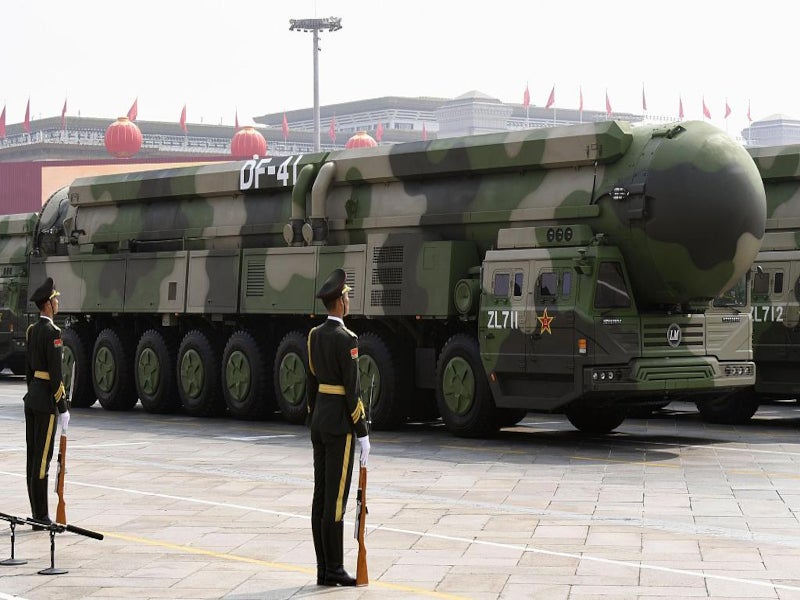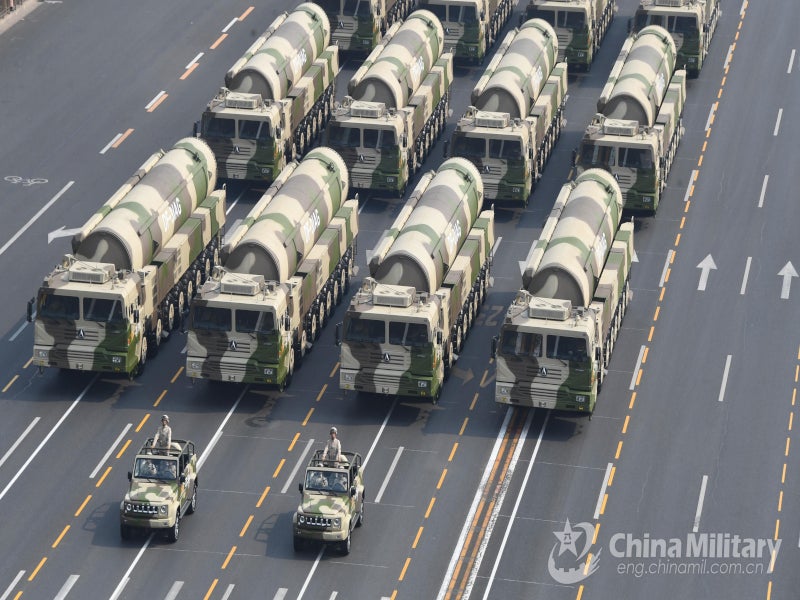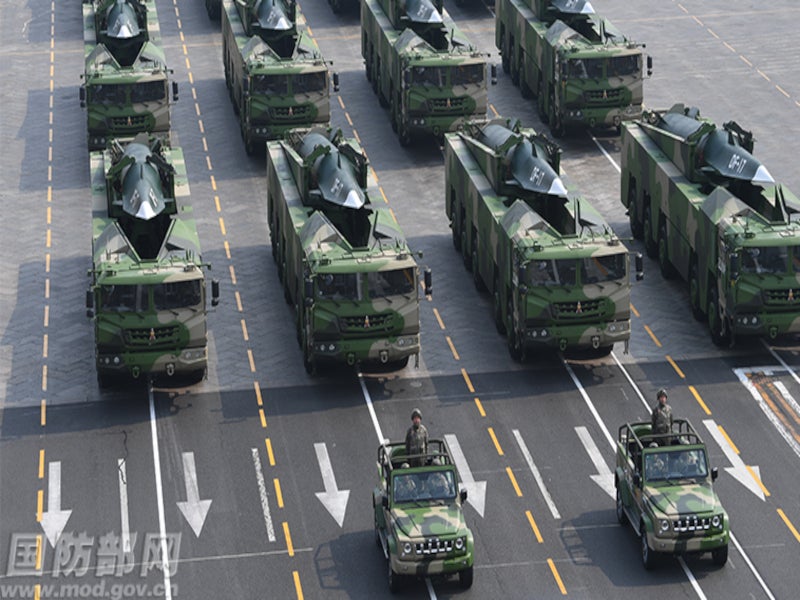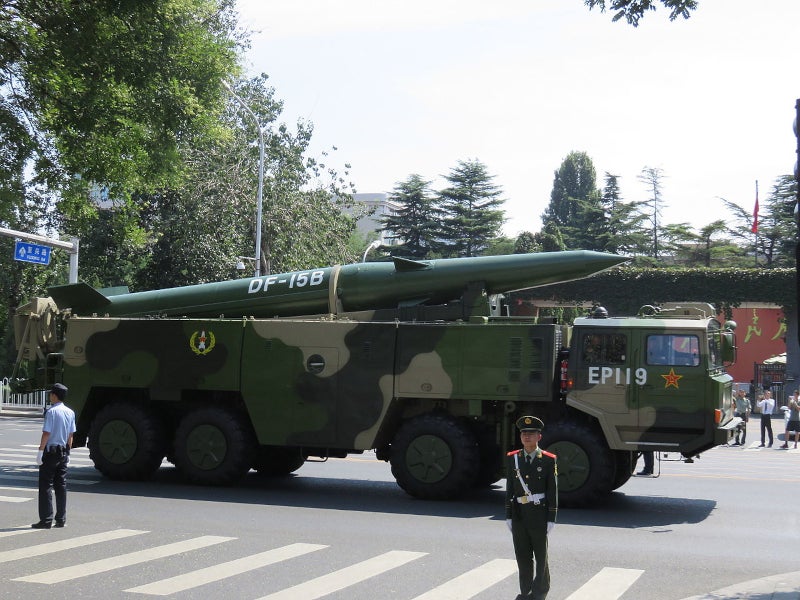The Dongfeng missiles, generally referred to as DF missiles, are a series of ballistic missiles with the capability to engage targets at short, medium, intermediate, and even intercontinental ranges. The DF missiles are operated by the Chinese People’s Liberation Army Rocket Force (PLARF).
Manufactured by the China Aerospace Science and Industry Corporation (CASIC), a state-owned aerospace and defence company, the wide range of DF missiles have diverse warhead carrying capabilities. The missiles significantly improved China’s deterrence abilities.
Reuters reported that the Chinese armed forces launched 11 DF ballistic missiles, including the DF-15 and a new version of DF-16 missiles, into the waters near the northeast and southwest coasts of Taiwan in August 2022.
DF-41 missile details
The DF-41 is a road-mobile intercontinental ballistic missile (ICBM), which can be launched from a transporter-erector launcher (TEL). It has a length of up to 22m, a diameter of 2.25m, and a launch weight of 80,000kg.
Powered by a three-stage solid propellant engine, the DF-41 is China’s longest-range missile with an operational range of up to 15,000km. Its extended range makes the missile capable of striking areas in the US, Europe, and Russia.
The missile can carry multiple independently targeted warheads (MIRV), including up to ten nuclear warheads, with a total payload weight of 2,500kg. The missile is carried by the Tian HTF5980 16×16 TEL.
The first flight test of the missile was conducted in July 2012. A canister-ejection test for the missile from a rail-mobile launcher was conducted in December 2015. The missile was unveiled to the public in October 2019.
A new type of missile silo was also constructed at the missile training area near Jilantai in inner Mongolia province.
DF-31 missile details
The DF-31 is a road-mobile ICBM having three variants, namely DF-31, DF-31A and DF-31AG.
The missile has a length of 15m, a diameter of 2m, and a launch weight of 42,000kg. It can carry a single nuclear warhead weighing up to 1,750kg.
Powered by a three-stage, solid-propellant, the missile can strike up to a range of 11,700km. The missile entered operational service in 2006.
DF-5 missile details
The DF-5 is a silo-based ICBM available in three variants, namely DF-5A, DF-5B, and DF-5C.
The 32.6m-long missile has a diameter of 3.35m and a launch weight of 183,000kg. It uses a two-stage liquid propellant engine. It has an operational range of 12,000km and a payload capacity of 3,900kg.
The missile can be armed with nuclear warhead with yield of one to three megatons (MT). The DF-5A can carry a single warhead, while the DF-5B can be armed with multiple warheads. The ICBM can also use chaff, decoys, or other penetration aids.
The DF-5 missile entered service with the People’s Liberation Army in 1981 and is stored in hardened silos in central China.
Dongfeng intermediate-range ballistic missiles details
The Dongfeng series has four intermediate-range ballistic missiles (IRBM), namely DF-3, DF-4, DF-25 and DF-26.
The DF-3 achieved initial operational capability in 1971. Several outdated DF-3 missiles were sold to Saudi Arabia.
The DF-3 is a silo-based IRBM developed with an effective range of 3,000km and capable of carrying nuclear or conventional warheads up to 2,000kg. It uses a single-stage liquid propellant engine and an inertial guidance system.
Designed to be China’s first modern missile, the DF-3 also provided the first stage for the two-stage transportable, liquid-fuelled DF-4 IRBM.
The DF-4 measures 28m in length and 2.25m in diameter, and weighs 82,000kg at launch. It has an effective range of up to 5,500km and can accommodate a single nuclear warhead with a yield of up to 3MT.
Developed with the aim of deploying a ballistic missile capable of hitting Guam, the missile has been in service since 1980.
The DF-25 is a two-stage solid-fuel missile, which has an operational range of 1,700km and can carry conventional warheads.
The DF-26 is a road-mobile, two-stage solid-fuel IRBM developed as China’s first nuclear-armed system with an operational range of 4,000km.
It has a length of 14m, a diameter of 1.4m, and a launch weight of 20,000kg. The missile can be armed with a conventional or nuclear warhead. It entered service with PLA in 2016, while its anti-ship variant DF-26B was tested in 2020.
Dongfeng medium-range ballistic missiles details
The Dongfeng series has three medium-range ballistic missiles (MRBM), namely DF-2, DF-17, and DF-21.
The DF-2 is a transportable MRBM with a length of 20.6m, a diameter of 1.65m, and a launch weight of 32,000kg. It uses a single-stage cryogenic fuel engine and an inertial guidance system. The DF-2A variant became operational with a nuclear warhead in 1966. Its production, however, ceased at the beginning of 1970.
The DF-2 was retired in 1979 and replaced with the more updated versions DF-3 and DF-21.
The DF-21 is a road-mobile, two-stage solid fuel MRBM which entered service in 1991. The 10.7m-long missile has a diameter of 1.4m and a launch weight of 14,700kg. It can carry a nuclear warhead with a yield of either 250 kiloton (kT) or 500kT or conventional high-explosive warhead up to a range of 2,150km.
The DF-21 series includes the DF-21, DF-21A/B/C, and an anti-ship variant DF-21D.
The DF-17, which has been in service since 2019, is a road-mobile MRBM equipped with a hypersonic glide vehicle. The 11m-long MRBM has a launch weight of 15,000kg and is capable of carrying conventional and nuclear warheads to a distance of up to 2,500km.
Dongfeng short-range ballistic missiles details
The Dongfeng series has five short-range ballistic missiles (SRBM), namely DF-1, DF-11, DF-12, DF-15, and DF-16.
Launched in November 1960, the DF-1 single-stage SRBM was armed with a conventional warhead and is no longer operational.
The DF-11 and DF-12 are road-mobile, single-stage solid-fuelled SRBMs. The 7.5m-long DF-11 can deliver up to 800kg payload, including nuclear, fuel-air explosive (FAE), chemical, or submunition warhead, up to 300km. It entered service in 1992.
The DF-12 has a length of 7.3m and a range of 420km. It can carry up to 480kg payload, including high-explosive, submunition, earth-penetrator, and thermobaric warhead. It entered service in 2013. Qatar uses the DF-12A variant of DF-12 missiles, which have a range of 280km and can carry a 480kg warhead.
The DF-15 and DF-16 are road-mobile, solid-fuelled SRBMs. The DF-15 is a 9.1m-long, 1m-diameter missile with a launch weight of 6,200kg. It has an effective range of up to 900km and can deliver a single warhead of up to 750kg. It has been operational since 1990.
The DF-16, which entered service in 2011, can deliver a payload of up to 1,000kg up to 1,000km range. It can be armed with up to three MIRV high explosive, nuclear or submunition warheads. The PLARF has deployed DF-16 in the Guangdong Province, with Taiwan and Vietnam within its target range.





